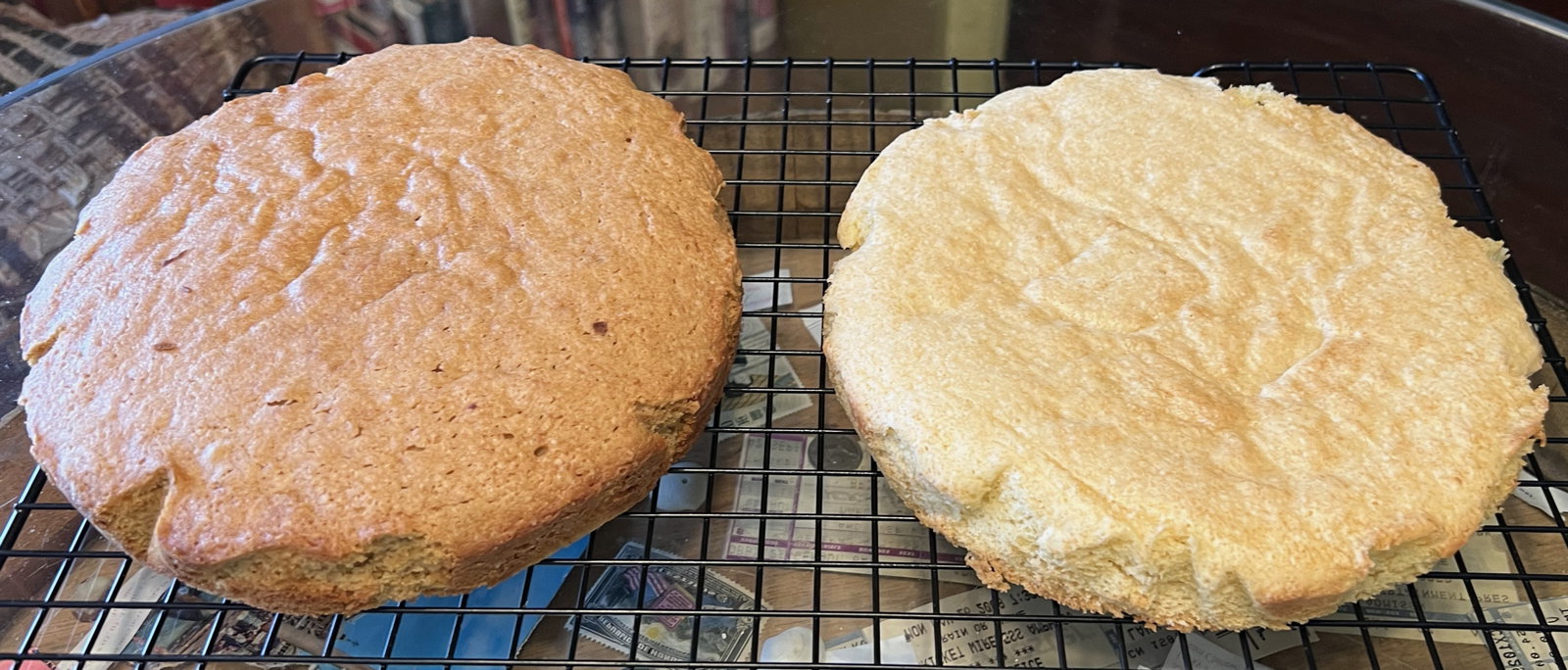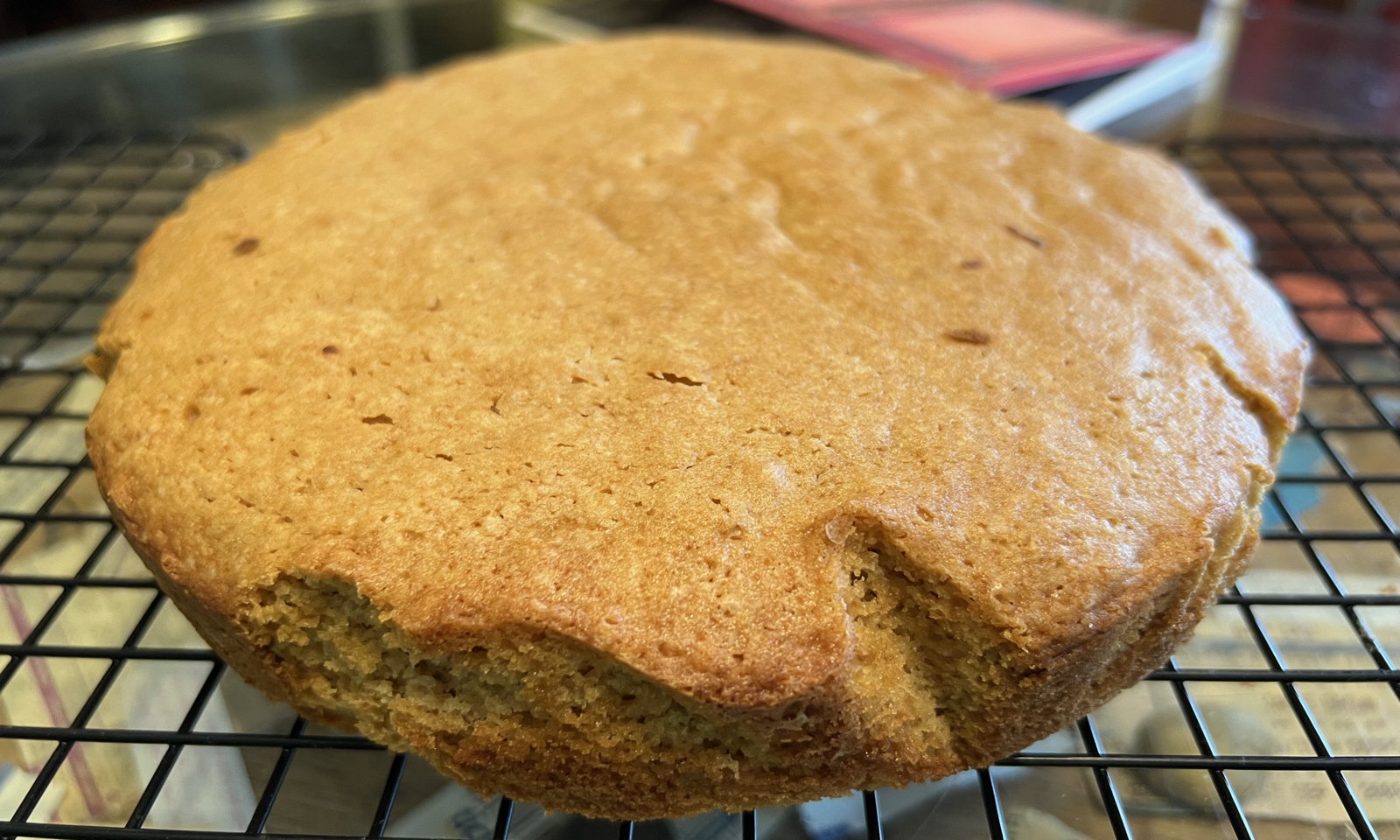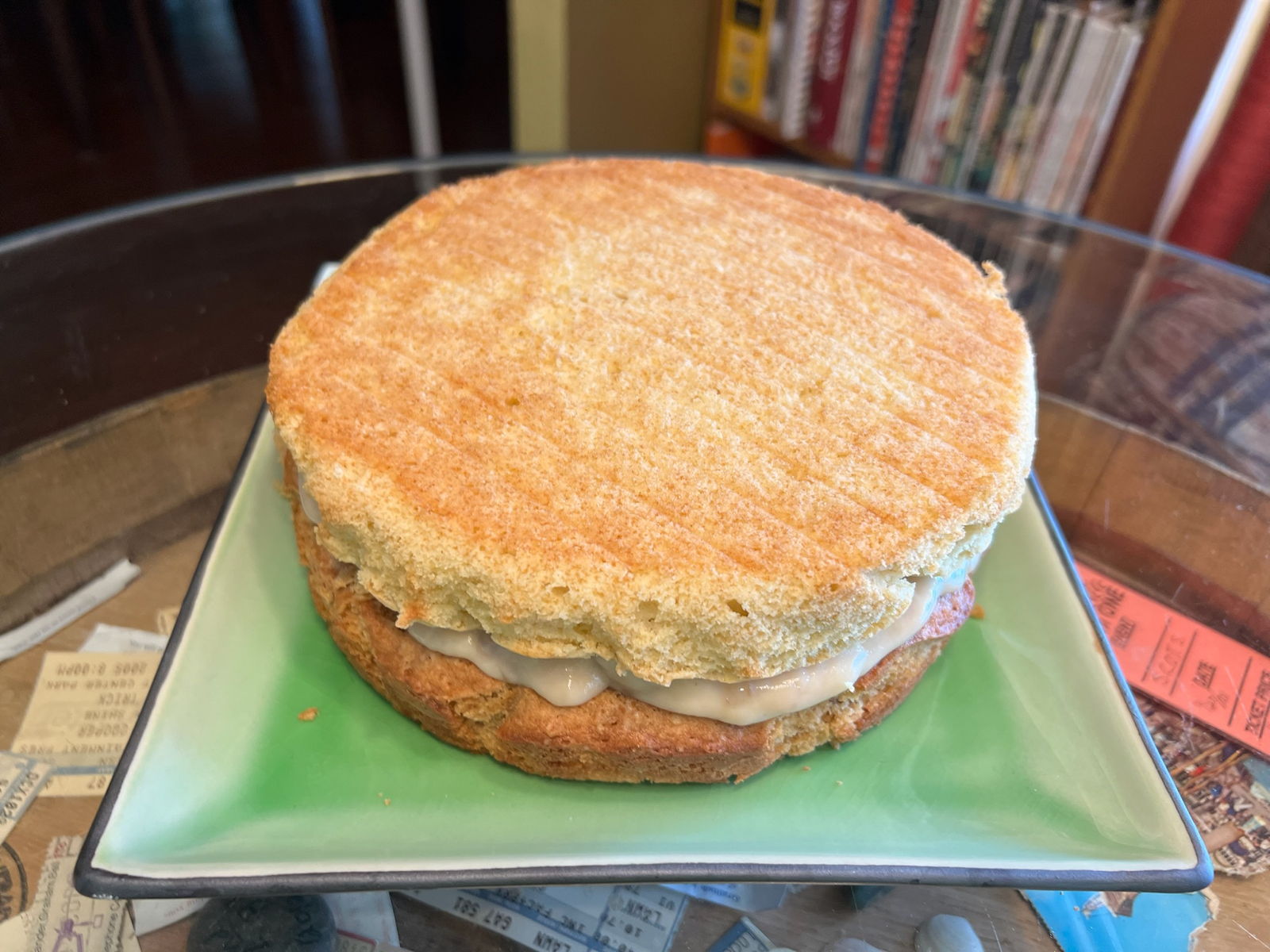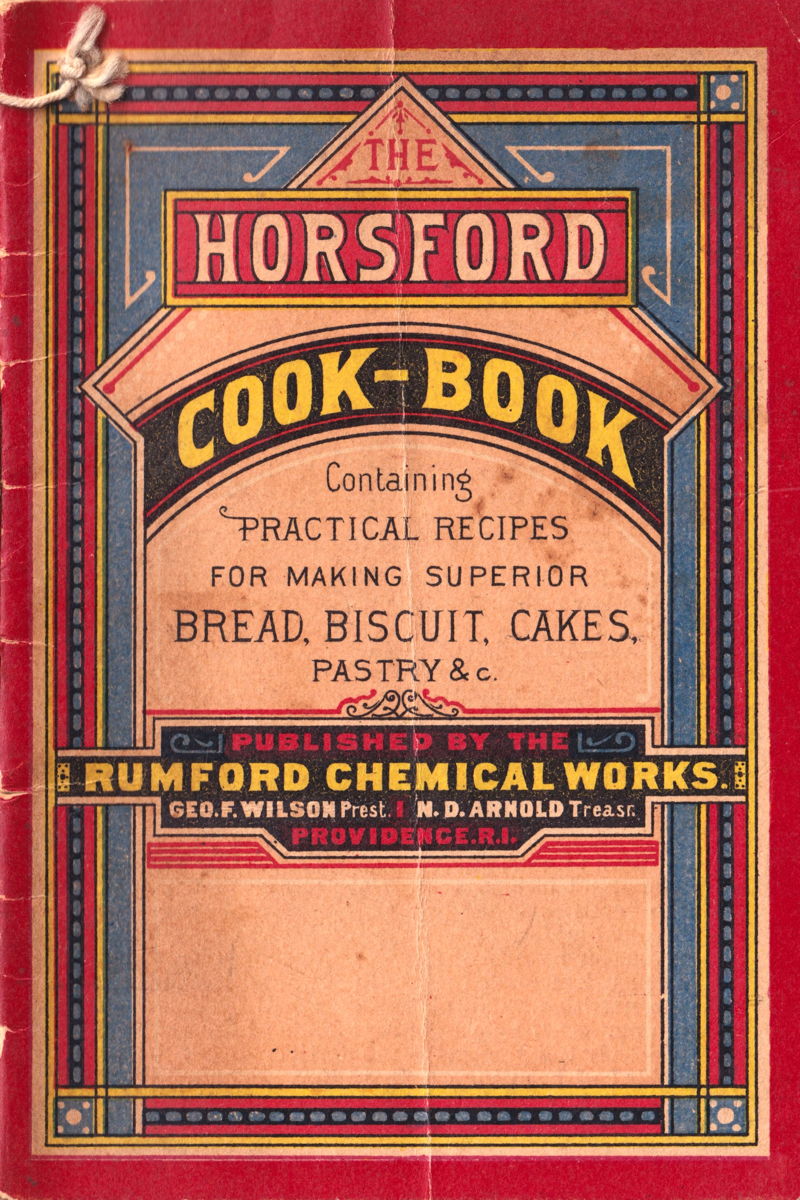Vintage cookbook reproductions, and gold cakes compared fifty years apart
I’ve added a new section to The Padgett Sunday Supper Club explicitly listing all of my print cookbooks in one place. Mainly this is to help you avoid excess shipping charges from Lulu if you enjoy reproductions of old cookbooks. All of the vintage reproductions, and most of the custom cookbooks, are available on Lulu.com.
If I wrote the book, it will be on both Amazon and Lulu. Reproductions will only be on Lulu. While Amazon does apparently allow books without the submitter’s name on the cover, they will also delay such books with questions. Navigating that sort of bureaucratic hassle is something I try to avoid.
Further, Amazon requires a bar code on the cover and I want to keep the cover reproductions clean. Some of them are quite beautiful. My first true reproduction is The Horsford Cook Book that I featured in A Centennial Meal for the Sestercentennial. It’s a wonderful book with some wonderful recipes. It’s the reason I decided to try printing reproductions. It’s not just that the recipes are great recipes, but the front and back cover are beautiful. At six inches by nine, I’ve published it larger than the original’s 3-⅝ inches by 5-½. If you enjoy putting such things on your walls, you may want to separate the cardstock cover and use the front and back as posters.
Since publishing reproductions via Lulu seems to work well I’ll be doing it with several other books I intend to feature in the future.
After posting A Centennial Meal back in June, I’ve made one more recipe from the Horsford book. I had six egg yolks left over from some Italian pudding and decided to try out a couple of gold cakes. I made the gold cake from Horsford and another gold cake from the 1926 Rumford Recipes for Cake and Cookie Making sliding cookbook.
They were very similar recipes. That’s not completely surprising; despite being separated by almost exactly fifty years, Horsford Acid Phosphate and Rumford Baking Powder were from the same company. One of the founders of Rumford was Eben Horsford, the “Rumford Professor and Lecturer on the Application of Science to the Useful Arts” at Harvard.1 In the 1870s or so when the Horsford Cook-Book was published, the company was named Rumford Chemical Works and based in Providence, Rhode Island.
In 1926, they were the Rumford Company of Providence, Rhode Island. And by 1929, when the second of their sliding cookbooks came out, they were The Rumford Company of Rumford, Rhode Island.
Here’s how the ingredients in the two recipes for gold cake compare, after converting each to be a two-yolk recipe:
| Horsford (ca. 1877) | Rumford (1926) |
|---|---|
| 2 egg yolks | 2 egg yolks |
| ⅔ cup brown sugar | ½ cup sugar |
| ⅓ cup butter | 1/8 cup butter, melted |
| 7 tbsp milk | 4 tbsp milk |
| 1-½ cups flour | 1 cup flour |
| 1 heaping tsp baking powder | ¾ tsp baking powder |
| vanilla | ½ tsp flavoring |
| no salt | ⅙ tsp salt |

The Horsford recipe originally called for three egg yolks, the Rumford recipe for four. Since I had three containers each containing two egg yolks, I chose to normalize to two egg yolks each. In a sense, they’re even more similar when they’re not prorated to two yolks. The twentieth-century Rumford recipe uses more yolk and less milk than the nineteenth-century Horsford recipe. As you can see in the actual recipes here (or in the books) the original recipes called for about 2-¼ cups flour for the older recipe with its three egg yolks and ⅔ cup milk; and 2 cups flour for the newer recipe with its four egg yolks and half cup of milk.

Horsford Gold Cake
Servings: 8
Preparation Time: 1 hour
The Horsford Cook-Book (PDF File, 4.7 MB)
Ingredients
- 3 egg yolks
- 1 cup brown sugar
- ½ cup butter
- ⅔ cup sour milk
- 2-¼ cup sifted flour
- ½ heaping tbsp baking powder
- ¾ tsp vanilla
Steps
- Beat the yolks and sugar together.
- Beat in the butter.
- Beat in the milk and vanilla.
- Sift flour and baking powder together into the batter.
- Mix well.
- Pour into two greased or lined 8-inch round cake pans.
- Bake at 350° for about 30 minutes.

The two cakes made a great layer cake.
Technically, the older recipe didn’t call for any specific amount of flour. It called for: “flour sufficient to make the mass as stiff as pound cake”. Leaving the flour amount entirely to consistency without any other guidelines was very common in nineteenth century recipes, I suspect because flour wasn’t yet as standard as it is today. I still find that if I’m using whole wheat flour, the amount necessary varies widely between different manufacturers. White flour, however, which this recipe calls for—even a hundred and fifty years ago, if the recipe didn’t specify the flour, it meant white flour—doesn’t seem to vary much at all today.
The Horsford recipe is also a brown sugar recipe, which makes it even more golden. It’s possible, especially given its format, that the slider assumes everyone knows that a gold cake uses brown sugar. As I wrote when I published it, the Rumford slider format meant even less in the way of instruction than other cookbooks of its period.
If gold cakes ever meant brown sugar that certainly isn’t the case today. All of the gold cakes I found in a simple online search just now use white sugar. I’m guessing it wasn’t the case then either—you have to make educated guesses much of the time with any recipe, especially ones from different time periods—and I used white sugar when I made it.
The two cakes made a very nice layer cake. I’m pretty sure that the gold cake in each case was not meant to be a layer cake, but since I was making two of them, each slightly smaller than their original, I chose to layer them with another test recipe. I made a vanilla cream pie filling from a 1960 high school notebook. I’ll have more on that later.

Rumford Gold Cake
Servings: 8
Preparation Time: 1 hour
Rumford Recipes Sliding Cookbooks (PDF File, 2.8 MB)
Ingredients
- 4 egg yolks
- 1 cup sugar
- ¼ cup very soft butter
- ½ cup sour milk
- 1 tsp vanilla
- 2 cups sifted flour
- 1-½ tsp baking powder
- ⅓ tsp salt
Steps
- Beat the sugar and yolks together.
- Beat in the butter and vanilla.
- Sift the flour, baking powder, and salt together into the batter.
- Mix, and pour into two greased or lined 8-inch cake pans.
They’re both very good cakes. The brown sugar version, obviously, tastes more of brown sugar: a lightly molasses or caramel flavor; it also has a bit more texture to it, which could be good or bad depending on what it’s needed for. Both are great without any frosting at all, if a little oddly shaped. They’d be great dusted with powdered sugar or with a good frosting added, the latter of which would also help cover the rough edges.
The rough edges on each cake come from my using wax paper to make them easy to remove, as specified in the general instructions for the Rumford slider. In a round pan, that makes for odd edges. If I were making this for a special occasion, I’d probably cut the wax paper round so that it only rests on the bottom, or just cut the rough edges away before serving.
In response to Vintage Cookbooks and Recipes: I have a couple of vintage cookbooks queued up to go online.
The Rumford professorship still existed at least a few years ago, as the Rumford Chair of Physics. It doesn’t appear to be a very public endowment; Harvard has nothing about it and the Wikipedia entry ends at 2018. However, if that list is comprehensive, the position occasionally lies empty, so it may still exist.
↑
Purchase now
- The Horsford Cook-Book: Jerry Stratton at My Lulu storefront (paperback)
- The Horsford Cook-Book is a circa 1877 pamphlet from the Rumford Chemical Works, and advertising Horsford Acid Phosphate. “Containing practical recipes for making superior bread, biscuit, cakes, pastry, &c.”
- Cookbooks on Lulu and Amazon
- I have several books and reproductions available on Lulu, and a few books available on Amazon. On Lulu especially, it helps to buy more than one book at a time to reduce shipping costs per book.
America’s Sestercentennial
- A Centennial Meal for the Sestercentennial
- How did Americans in 1876 celebrate the centennial culinarily? Some of their recipes are surprisingly modern, and some are unique flavors worthy of resurrecting.
Rumford Chemical Works
- Rumford Chair of Physics at Wikipedia
- “The Rumford Chair of Physics (originally the Rumford Chair and Lectureship on the Application of Science to the Useful Arts) is an endowed professorship established at Harvard University in 1816 under the will of Benjamin Thompson, Count Rumford.”
- Rumford Recipes Sliding Cookbooks
- One of the most interesting experiments in early twentieth century promotional baking pamphlets is this pair of sliding recipe cards from Rumford.
vintage cookbooks
- Padgett Sunday Supper Club
- Dedicated to the preservation of vintage recipes.
More food history
- Mrs. Winslow’s Domestic Receipt Book for 1876
- If this is what people were eating in 1876, they were eating very well. From coconut pie to molasses gingerbread to tomato jam, these are great recipes—albeit requiring some serious interpretation.
- The New Centennial Cook Book
- Over 100 Valuable Receipts for Cakes, Pies, Puddings, etc.… borrowed verbatim from other cookbooks.
- Quiet ovens and Australian rice shortbread
- What is a quiet oven? How do we translate old recipes? Executive summary: 325°; very carefully. Plus, two Australian recipes for rice shortbread as a test of my theory.
- Stoy Soy Flour: Miracle Protein for World War II
- To replace protein lost by rationing, add the concentrated protein of Stoy’s soy flour to your baked goods and other dishes!
- Rumford Recipes Sliding Cookbooks
- One of the most interesting experiments in early twentieth century promotional baking pamphlets is this pair of sliding recipe cards from Rumford.
- 18 more pages with the topic food history, and other related pages
More Rumford Chemical Works
- Rumford Recipes Sliding Cookbooks
- One of the most interesting experiments in early twentieth century promotional baking pamphlets is this pair of sliding recipe cards from Rumford.

